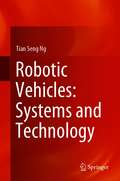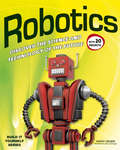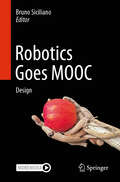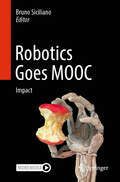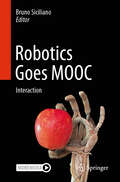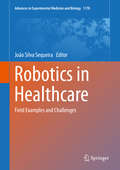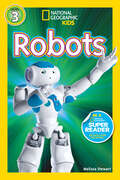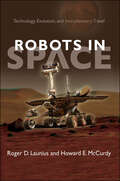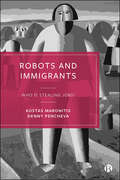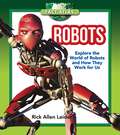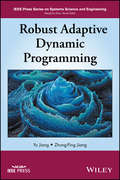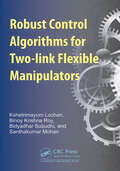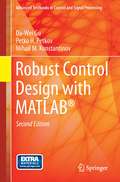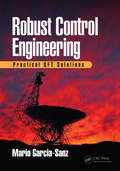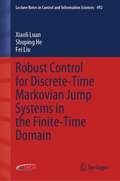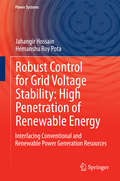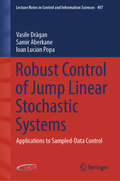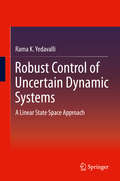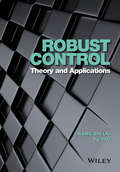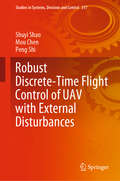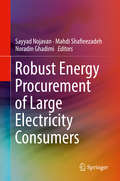- Table View
- List View
Robotic Vehicles: Systems and Technology
by Tian Seng NgThis book introduces the technological innovations of robotic vehicles. It presents the concepts required for self-driving cars on the road. Besides, readers can gain invaluable knowledge in the construction, programming, and control of the six-legged robot. The book also presents the controllers and aerodynamics of several different types of rotorcrafts. It includes the simulation and flight of the various kinds of rotor-propelled air vehicles under each of their different aerodynamics environment. The book is suitable for academia, educators, students, and researchers who are interested in autonomous vehicles, robotics, and rotor-propelled vehicles.
Robotics
by Kathy Ceceri Sam CarbaughOnce, robots were only found in science fiction books and movies. Today, robots are everywhere! They assemble massive cars and tiny computer chips. They help doctors do delicate surgery. They vacuum our houses and mow our lawns. Robot toys play with us, follow our commands, and respond to our moods. We even send robots to explore the depths of the ocean and the expanse of space. In Robotics, children ages 9 and up learn how robots affect both the future and the present. Hands-on activities make learning both fun and lasting.
Robotics Goes MOOC: Design
by Bruno SicilianoA robot’s appearance and its way of interacting with humans is of fundamental importance. Until a few years ago there was a clear asymmetry between the typically excellent performance of industrial robots and their ugly and disharmonious bodies, with crude ways and potentially very dangerous movements for the human environment. A modern artifact can be as harmonious and beautiful as a complex biological machine or a work of plastic art and thus it should be clear how design plays a key role for robot technology to become a part of our everyday life and change it essentially in a responsible and beneficial manner. It is designers who shape the interface between humans and machines and, as such, they will contribute to make robots as customizable and intuitively useful to inexperienced users according to a plug-and-play mode. The new concept of robotronics as the mechatronics approach to designing advanced robots is the focus of the first chapter of the second book of the Robotics Goes MOOC project by Asfour et al. The main issues for robot manipulator design are covered in the subsequent material, namely redundant robots in Chapter 2 by Maciejewsky et al and parallel robots in Chapter 3 by Müller, where widely adopted kinematic solutions are presented. Then, the adoption to flexibilty, as opposed to the rigid mechanics paradigm, is discussed in Chapter 4 by Bertram et al with reference to elastic robots and in Chapter 5 by Laschi focused on soft robotics. Somewhat speculating on the previous two design solutions comes Chapter 6 by Cutkosky dealing with bioinspired robots. The last part of the book is devoted to robot locomotion, namely, Chapter 7 by Vendittelli on wheeled robots and Chapter 8 by Harada on (biped) humanoids.
Robotics Goes MOOC: Impact
by Bruno SicilianoIt is often read in the media that AI and Robotics are the primary cause of technology unemployment. AI and machine learning techniques are expected to take over lower-level tasks, while humans can spend more time with higher-level tasks. In perspective, it can be said that jobs requiring boring cognitive tasks or repeatable and dangerous physical tasks will be considerably shredded by automation thanks to the wide adoption of AI & Robotics technology to replace humans, while jobs requiring challenging cognitive tasks or unstructured physical tasks will be suitably re-engineered with the progressive introduction of AI & Robotics technology to assist humans.From the discussion above, it should be clear that in a world populated by humans and robots, issues arise that go beyond engineering and technology due to the impact resulting from the use of robots in various application scenarios. The anthropization of robots cannot ignore the resolution of those ethical, legal, sociological, economic (ELSE) problems that have so far slowed their spread in our society.The final book of the Robotics Goes MOOC project enlightens the impact of using robotic technology in the main fields of application, namely, industrial robots as in Chapter 1 by Bischoff et al, medical robotics as in Chapter 2 by Dario et al, aerial robots as in Chapter 3 by Ollero et al, orbital robotics as in Chapter 4 by Lampariello, underwater robots in Chapter 5 by Antonelli, and rescue robots as in Chapter 6 by Murphy. The last part is devoted to the open dilemma of using and accepting robots in human co-habited environments which is addressed in Chapter 7 on social robotics by Pandey and the very final chapter by Tamburrini on the important issues raised with roboethics.
Robotics Goes MOOC: Interaction
by Bruno SicilianoWith the massive and pervasive diffusion of robotics technology in our society, we are heading towards a new type of AI, which we call Physical AI at the intersection of Robotics with AI, that is the science of robots and intelligent machines performing a physical action to help humans in their jobs of daily lives. Physical assistance to disabled or elderly people; reduction of risks and fatigue at work; improvement of production processes of material goods and their sustainability; safety, efficiency and reduction of environmental impact in transportation of people and goods; progress of diagnostic and surgical techniques are all examples of scenarios where the new InterAction Technology (IAT) is indispensable.The interaction between robots and humans must be managed in a safe and reliable manner. The robot becomes an ideal assistant, like the tool used by a surgeon, a craftsman, a skilled worker. The new generation of robots will co-exist — the cobots— with humans not only in the workplace but, gradually, in homes and communities, providing support in services, entertainment, education, health, manufacturing and care.As widely discussed above, interaction plays a crucial role for the development of modern robotic systems. Grasping, manipulation and cooperative manipulators are covered in the first part of the third book of the Robotics Goes MOOC project, respectively in Chapter 1 by Prattichizzo et al, Chapter 2 by Kao et al, and Chapter 3 by Caccavale. Specific interaction issues along with the development of digital and physical interfaces are dealt with in Chapter 4 by Marchal et al and in Chapter 5 by Croft et al, respectively. Interaction between robot and human also means that a robot can be worn by a human as presented in Chapter 6 by Vitiello et al. A different type of interaction at a cognitive and planning level is the focus of Chapter 7 by Lima devoted to multi-robot systems and Chapter 8 by Song et al on networked, cloud and fog robotics, respectively.
Robotics Goes MOOC: Knowledge
by Bruno SicilianoThe robot “concept” was clearly established by those many creative historical realizations, such as those recalled above. Nonetheless, the emergence of the “physical” robot had to await the advent of its underlying technologies of mechanics, controls, computers, electronics and sensors ―in one word, mechatronics― during the course of the twentieth century. As always, new designs motivate new research and discoveries which, in turn, lead to enhanced solutions and thus to novel concepts. This virtuous circle over time produced that knowledge and understanding which gave birth to the field of Robotics, properly referred to as the science and technology of robots.To make robots and intelligent machines useful to humans it is necessary to have a broad and tight intersection between Robotics and AI. Sophisticated mathematical models are needed that enable the robot from a physical point of view, as well as intelligent algorithms capable of correlating all the information coming from the use of technologically advanced sensors with the data available from experience. It is expected that the synergy of model-based techniques with data-driven approaches will contribute to increasing the level of autonomy of robots and intelligent machines in the near future.The first book of the Robotics Goes MOOC project starts with the journey of robotics in the introductory chapter by Khatib, who has pioneered our field of robotics and has ferried it to the third millennium. Sensing is crucial for the development of intelligent and autonomous robots, as covered in Chapter 2 by Nüchter et al. Model-based control is dealt with in Chapter 3 by Kröeger et al along with motion planning, as well as in Chapter 4 by Villani and Chapter 5 by Chaumette to handle force and visual feedback, respectively, when interacting with the environment. Resorting to AI techniques is the focus of the last part of the book, namely, Chapter 6 by Peters et al on Learning, Chapter 7 byBeetz et al on knowledge representation and reasoning, and Chapter 8 by Burgard et al on graph-based SLAM.
Robotics and Mechatronics for Agriculture
by Dan Zhang Bin WeiThe aim of the book is to introduce the state-of-the-art technologies in the field of robotics, mechatronics and automation in agriculture in order to summarize and review the improvements in the methodologies in agricultural robotics. Advances made in the past decades are described, including robotics for agriculture, mechatronics for agriculture, kinematics, dynamics and control analysis of agricultural robotics, and a wide range of topics in the field of robotics, mechatronics and automation for agricultural applications.
Robotics in Healthcare: Field Examples and Challenges (Advances in Experimental Medicine and Biology #1170)
by João Silva SequeiraThe work is a collection of contributions resulting from R&D efforts originated from scientific projects involving academia, technological partners, and end-user institutions. The aim is to provide a comprehensive overview of robotics technology applied to Healthcare, and discuss the anticipation of upcoming challenges.The intersection of Robotics and Medicine includes socially and economically relevant areas, such as rehabilitation, therapy, and healthcare. Innovative usages of current robotics technologies are being somewhat stranded by concerns related to social dynamics. The examples covered in this volume show some of the potential societal benefits robotics can bring and how the robots are being integrated in social environments.Despite the aforementioned concerns, a fantastic range of possibilities is being opened. The current trend in social robotics adds to technology challenges and requires R&D to think about Robotics as an horizontal discipline, intersecting social and exact sciences. For example, robots that can act as if they have credible personalities (not necessarily similar to humans) living in social scenarios, eventually helping people. Also, robots can move inside the human body to retrieve information that otherwise is difficult to obtain. The decision autonomy of these robots raises a broad range of subjects though the immediate advantages of its use are evident.The book presents examples of robotics technologies tested in healthcare environments or realistically close to being deployed in the field and discusses the challenges involved. Chapter 1 provides a comprehensive overview of Healthcare robotics and points to realistically expectable developments in the near future. Chapter 2 describes the challenges deploying a social robot in the Pediatrics ward of an Oncological hospital for simple edutainment activities. Chapter 3 focuses on Human-Robot Interaction techniques and their role in social robotics. Chapter 4 focus on R&D efforts behind an endoscopic capsule robot. Chapter 5 addresses experiments in rehabilitation with orthotics and walker robots. These examples have deep social and economic relations with the Healthcare field, and, at the same time, are representative of the R&D efforts the robotics community is developing.
Robots (National Geographic Kids Readers)
by Melissa StewartDiscover the coolest robots of today and tomorrow in this colorful, photo-packed book. In this inviting and entertaining format, kids will learn about the science behind these amazing machines. This Level 3 reader is written in an easy-to-grasp style to encourage the scientists of tomorrow!National Geographic supports K-12 educators with ELA Common Core Resources.Visit www.natgeoed.org/commoncore for more information.
Robots In Space: Technology, Evolution, and Interplanetary Travel (New Series in NASA History)
by Roger D. Launius Howard E. McCurdyA look into the history of space exploration and its possible future, and just where exactly robotics fit into it all.Given the near incomprehensible enormity of the universe, it appears almost inevitable that humankind will one day find a planet that appears to be much like the Earth. This discovery will no doubt reignite the lure of interplanetary travel. Will we be up to the task? And, given our limited resources, biological constraints, and the general hostility of space, what shape should we expect such expeditions to take?In Robots in Space, Roger Launius and Howard McCurdy tackle these questions with rigorous scholarship and disciplined imagination, jumping comfortably among the worlds of rocketry, engineering, public policy, and science fantasy to expound upon the possibilities and improbabilities involved in trekking across the Milky Way and beyond. They survey the literature—fictional as well as academic studies—and outline the progress of space programs in the United States and other nations. They also assess the current state of affairs to offer a conclusion startling only to those who haven’t spent time with Asimov, Heinlein, and Clarke: to traverse the cosmos, humans must embrace and entwine themselves with advanced robotic technologies . . .2008 Outstanding Academic Title, Choice MagazinePraise for Robots in Space“This short volume manages to capture the history of U.S. space flight, to explain the underpinnings of U.S. space policy and to plot out the possibilities for our future in space in a style that most anyone can enjoy.” —Andrew McMichael, Park City Daily News
Robots and Immigrants: Who Is Stealing Jobs?
by Kostas Maronitis Denny PenchevaWho steals jobs? Who owns jobs? Focusing on the competitive labour market, this book scrutinises the narratives created around immigration and automation. The authors explore how the advances in AI and demands for constant flow of immigrant workers eradicate political and working rights, fuelling fears over job theft and ownership. Shedding light on the multiple ways in which employment is used as an instrument of neoliberal governance, this revealing book sparks new debate on the role of automation and migration policies. It is an invaluable resource for academics and practitioners working in the areas of immigration and labour, capitalism and social exclusion, and economic models and political governance.
Robots in Space (Fountas & Pinnell LLI Purple #Level U)
by Kathleen Krull Paul BrewerA Solution in Space. Space travel is exciting--seeing what other planets look like, finding out about the origins of the universe, and creating brand-new technologies. But sending a manned mission out into deep space presents huge risks and obstacles. A solution is here: robots. They can take our place in space, and in fact, we've already sent robots to explore the planet Mars. Robots are probably the only way that earthlings will ever get to see what is out there--way, way out there!
Robots in Space: Technology, Evolution, and Interplanetary Travel (New Series in NASA History)
by Roger D. Launius Howard E. McCurdy2008 Outstanding Academic Title, Choice MagazineGiven the near incomprehensible enormity of the universe, it appears almost inevitable that humankind will one day find a planet that appears to be much like the Earth. This discovery will no doubt reignite the lure of interplanetary travel. Will we be up to the task? And, given our limited resources, biological constraints, and the general hostility of space, what shape should we expect such expeditions to take?In Robots in Space, Roger Launius and Howard McCurdy tackle these seemingly fanciful questions with rigorous scholarship and disciplined imagination, jumping comfortably among the worlds of rocketry, engineering, public policy, and science fantasy to expound upon the possibilities and improbabilities involved in trekking across the Milky Way and beyond. They survey the literature—fictional as well as academic studies; outline the progress of space programs in the United States and other nations; and assess the current state of affairs to offer a conclusion startling only to those who haven't spent time with Asimov, Heinlein, and Clarke: to traverse the cosmos, humans must embrace and entwine themselves with advanced robotic technologies.Their discussion is as entertaining as it is edifying and their assertions are as sound as they are fantastical. Rather than asking us to suspend disbelief, Robots in Space demands that we accept facts as they evolve.
Robots: Explore the World of Robots and How They Work for Us (Fact Atlas Series)
by Rick Allen LeiderRobots exist for so many different reasons. Many robots replace humans, whether it’s because a situation is dangerous or just tedious. There are rover robots to explore space and drone robots that play a part in our military today, but then there are also vacuum robots available for the average household’s chores. In Japan, there is a robot teacher that can mimic a wide range of human emotions--including anger at uncooperative students--thanks to eighteen small motors hidden beneath the latex skin covering her face. The Japanese government hopes to use robots to fill jobs left vacant by an anticipated labor shortage due to an aging population. In the United States, robots even help with surgery, allowing for incisions to be cut much smaller than they would be otherwise--meaning fewer complications and faster recovery times. This fascinating book in the Fact Atlas series explores the history of robots, from the very first robot designed by Leonardo da Vinci to predictions of the roles robots will play in our future. Kids will learn about how robots are often modeled after real life-forms, such as bees, sharks, and, of course, humans. Robots also takes into account the robots in pop culture--robots we have imagined could be a part of our future. Readers can decide for themselves whether or not they think robots should be developed to their fullest potential or kept in check by safety limitations.
Robust Adaptive Dynamic Programming
by Zhong-Ping Jiang Yu JiangA comprehensive look at state-of-the-art ADP theory and real-world applications This book fills a gap in the literature by providing a theoretical framework for integrating techniques from adaptive dynamic programming (ADP) and modern nonlinear control to address data-driven optimal control design challenges arising from both parametric and dynamic uncertainties. Traditional model-based approaches leave much to be desired when addressing the challenges posed by the ever-increasing complexity of real-world engineering systems. An alternative which has received much interest in recent years are biologically-inspired approaches, primarily RADP. Despite their growing popularity worldwide, until now books on ADP have focused nearly exclusively on analysis and design, with scant consideration given to how it can be applied to address robustness issues, a new challenge arising from dynamic uncertainties encountered in common engineering problems. Robust Adaptive Dynamic Programming zeros in on the practical concerns of engineers. The authors develop RADP theory from linear systems to partially-linear, large-scale, and completely nonlinear systems. They provide in-depth coverage of state-of-the-art applications in power systems, supplemented with numerous real-world examples implemented in MATLAB. They also explore fascinating reverse engineering topics, such how ADP theory can be applied to the study of the human brain and cognition. In addition, the book: Covers the latest developments in RADP theory and applications for solving a range of systems’ complexity problems Explores multiple real-world implementations in power systems with illustrative examples backed up by reusable MATLAB code and Simulink block sets Provides an overview of nonlinear control, machine learning, and dynamic control Features discussions of novel applications for RADP theory, including an entire chapter on how it can be used as a computational mechanism of human movement control Robust Adaptive Dynamic Programming is both a valuable working resource and an intriguing exploration of contemporary ADP theory and applications for practicing engineers and advanced students in systems theory, control engineering, computer science, and applied mathematics.
Robust Control Algorithms for Flexible Manipulators
by Santhakumar Mohan Bidyadhar Subudhi Kshetrimayum Lochan Binoy Krishna RoyVarious modelling and control of two-link flexible manipulators are presented in this book. The lumped parameter modelling method and the assumed modes method modelling are comprehensively reviewed. The book also reviews the trajectory tracking problem and tip trajectory tracking problem along with the suppression of tip deflection of the links. An exponential time varying signal and a chaotic signal are considered as the desired trajectories. The identical/ non-identical slave manipulator is synchronised with the controlled master manipulator so that the slave manipulator indirectly follows the desired manipulator.
Robust Control Design with MATLAB®
by Da-Wei Gu Mihail M Konstantinov Petko H. PetkovRobust Control Design with MATLAB® (second edition) helps the student to learn how to use well-developed advanced robust control design methods in practical cases. To this end, several realistic control design examples from teaching-laboratory experiments, such as a two-wheeled, self-balancing robot, to complex systems like a flexible-link manipulator are given detailed presentation. All of these exercises are conducted using MATLAB® Robust Control Toolbox 3, Control System Toolbox and Simulink®. By sharing their experiences in industrial cases with minimum recourse to complicated theories and formulae, the authors convey essential ideas and useful insights into robust industrial control systems design using major H-infinity optimization and related methods allowing readers quickly to move on with their own challenges. The hands-on tutorial style of this text rests on an abundance of examples and features for the second edition: * rewritten and simplified presentation of theoretical and methodological material including original coverage of linear matrix inequalities; * new Part II forming a tutorial on Robust Control Toolbox 3; * fresh design problems including the control of a two-rotor dynamic system; and * end-of-chapter exercises. Electronic supplements to the written text that can be downloaded from extras.springer.com/isbn include: * M-files developed with MATLAB® help in understanding the essence of robust control system design portrayed in text-based examples; * MDL-files for simulation of open- and closed-loop systems in Simulink®; and * a solutions manual available free of charge to those adopting Robust Control Design with MATLAB® as a textbook for courses. Robust Control Design with MATLAB® is for graduate students and practising engineers who want to learn how to deal with robust control design problems without spending a lot of time in researching complex theoretical developments.
Robust Control Engineering: Practical QFT Solutions
by Mario Garcia-SanzThis book thoroughly covers the fundamentals of the QFT robust control, as well as practical control solutions, for unstable, time-delay, non-minimum phase or distributed parameter systems, plants with large model uncertainty, high-performance specifications, nonlinear components, multi-input multi-output characteristics or asymmetric topologies. The reader will discover practical applications through a collection of fifty successful, real world case studies and projects, in which the author has been involved during the last twenty-five years, including commercial wind turbines, wastewater treatment plants, power systems, satellites with flexible appendages, spacecraft, large radio telescopes, and industrial manufacturing systems. Furthermore, the book presents problems and projects with the popular QFT Control Toolbox (QFTCT) for MATLAB, which was developed by the author.
Robust Control for Discrete-Time Markovian Jump Systems in the Finite-Time Domain (Lecture Notes in Control and Information Sciences #492)
by Fei Liu Shuping He Xiaoli LuanThis book provides robust analysis and synthesis tools for Markovian jump systems in the finite-time domain with specified performances. It explores how these tools can make the systems more applicable to fields such as economic systems, ecological systems and solar thermal central receivers, by limiting system trajectories in the desired bound in a given time interval.Robust Control for Discrete-Time Markovian Jump Systems in the Finite-Time Domain focuses on multiple aspects of finite-time stability and control, including: finite-time H-infinity control;finite-time sliding mode control;finite-time multi-frequency control;finite-time model predictive control; andhigh-order moment finite-time control for multi-mode systems and also provides many methods and algorithms to solve problems related to Markovian jump systems with simulation examples that illustrate the design procedure and confirm the results of the methods proposed.The thorough discussion of these topics makes the book a useful guide for researchers, industrial engineers and graduate students alike, enabling them systematically to establish the modeling, analysis and synthesis for Markovian jump systems in the finite-time domain.
Robust Control for Grid Voltage Stability: High Penetration of Renewable Energy
by Jahangir Hossain Hemanshu Roy PotaThis book makes the area of integration of renewable energy into the existing electricity grid accessible to engineers and researchers. This is a self-contained text which has models of power system devices and control theory necessary to understand and tune controllers in use currently. The new research in renewable energy integration is put into perspective by comparing the change in the system dynamics as compared to the traditional electricity grid. The emergence of the voltage stability problem is motivated by extensive examples. Various methods to mitigate this problem are discussed bringing out their merits clearly. As a solution to the voltage stability problem, the book covers the use of FACTS devices and basic control methods. An important contribution of this book is to introduce advanced control methods for voltage stability. It covers the application of output feedback methods with a special emphasis on how to bound modelling uncertainties and the use of robust control theory to design controllers for practical power systems. Special emphasis is given to designing controllers for FACTS devices to improve low-voltage ride-through capability of induction generators. As generally PV is connected in low voltage distribution area, this book also provides a systematic control design for the PV unit in distribution systems. The theory is amply illustrated with large IEEE Test systems with multiple generators and dynamic load. Controllers are designed using Matlab and tested using full system models in PSSE.
Robust Control of Jump Linear Stochastic Systems: Applications to Sampled-Data Control (Lecture Notes in Control and Information Sciences #497)
by Vasile Drăgan Samir Aberkane Ioan Lucian PopaThis monograph concentrates on the theory of robust control of linear impulsive stochastic systems and stochastic systems with jumps. It discusses theoretical points concerned with impulsive stochastic systems including optimal control, robust stabilization, and H2- and Hinfinity-type results. Considering the major role played by the impulsive Lyapunov and impulsive Riccati equations in these problems, the book presents a thorough treatment of these equations in a general framework. It also presents various applications to sampled-data control. Robust Control of Jump Linear Stochastic Systems is a self-contained and clearly structured presentation of up-to-date research in this area, relevant to researchers in control theory and to non-specialists who are interested in the theory of robust control of linear impulsive stochastic systems. Theoretical and applied mathematicians, research engineers, and graduate students in the aforementioned fields will also find value in this book.
Robust Control of Uncertain Dynamic Systems
by Rama K. YedavalliThis textbook aims to provide a clear understanding of the various tools of analysis and design for robust stability and performance of uncertain dynamic systems. In model-based control design and analysis, mathematical models can never completely represent the "real world" system that is being modeled, and thus it is imperative to incorporate and accommodate a level of uncertainty into the models. This book directly addresses these issues from a deterministic uncertainty viewpoint and focuses on the interval parameter characterization of uncertain systems. Various tools of analysis and design are presented in a consolidated manner. This volume fills a current gap in published works by explicitly addressing the subject of control of dynamic systems from linear state space framework, namely using a time-domain, matrix-theory based approach. This book also: Presents and formulates the robustness problem in a linear state space model framework. Illustrates various systems level methodologies with examples and applications drawn from aerospace, electrical and mechanical engineering. Provides connections between lyapunov-based matrix approach and the transfer function based polynomial approaches. Robust Control of Uncertain Dynamic Systems: A Linear State Space Approach is an ideal book for first year graduate students taking a course in robust control in aerospace, mechanical, or electrical engineering.
Robust Control: Theory and Applications
by Kang-Zhi Liu Yu YaoComprehensive and up to date coverage of robust control theory and its application• Presented in a well-planned and logical way• Written by a respected leading author, with extensive experience in robust control• Accompanying website provides solutions manual and other supplementary material
Robust Discrete-Time Flight Control of UAV with External Disturbances (Studies in Systems, Decision and Control #317)
by Peng Shi Mou Chen Shuyi ShaoThis book studies selected discrete-time flight control schemes for fixed-wing unmanned aerial vehicle (UAV) systems in the presence of system uncertainties, external disturbances and input saturation. The main contributions of this book for UAV systems are as follows: (i) the proposed integer-order discrete-time control schemes are based on the designed discrete-time disturbance observers (DTDOs) and the neural network (NN); and (ii) the fractional-order discrete-time control schemes are developed by using the fractional-order calculus theory, the NN and the DTDOs. The book offers readers a good understanding of how to establish discrete-time tracking control schemes for fixed-wing UAV systems subject to system uncertainties, external wind disturbances and input saturation. It represents a valuable reference guide for academic research on uncertain UAV systems, and can also support advanced / Ph.D. studies on control theory and engineering.
Robust Energy Procurement of Large Electricity Consumers
by Sayyad Nojavan Mahdi Shafieezadeh Noradin GhadimiThis book identifies the challenges faced by large electricity consumers when they use several sources to procure their energy. The huge penetration of distributed energy resources and the intermittent nature of renewables can put the operations of the large electricity consumer at risk. The book discusses the different types of energy sources including the pool market, bilateral contracts, electrical vehicles, energy storage systems, and demand response programs in detail and presents solutions for robust and risk based scheduling. The author provides models for determining and considering uncertainties and optimal bidding strategies. The book is useful to engineers and students involved in the integration of various energy types as well as those working in state and federal governmental organizations who regulate different aspects of electricity market operation and planning.Presents solutions for robust and risk based scheduling;Discusses the operation and planning of energy storage systems;Presents the most-up-to-date technological approaches to energy integration.
